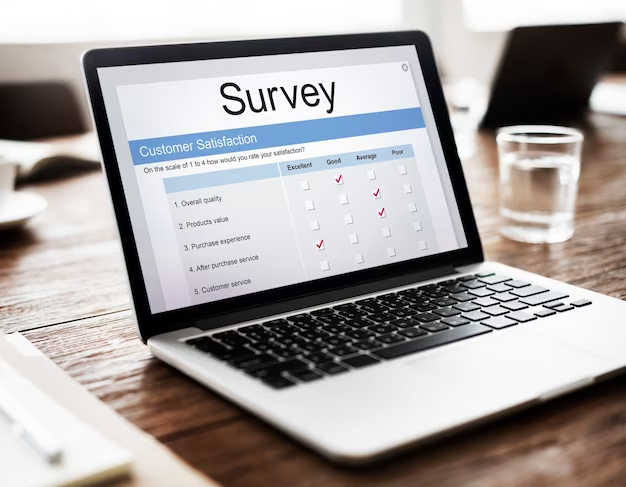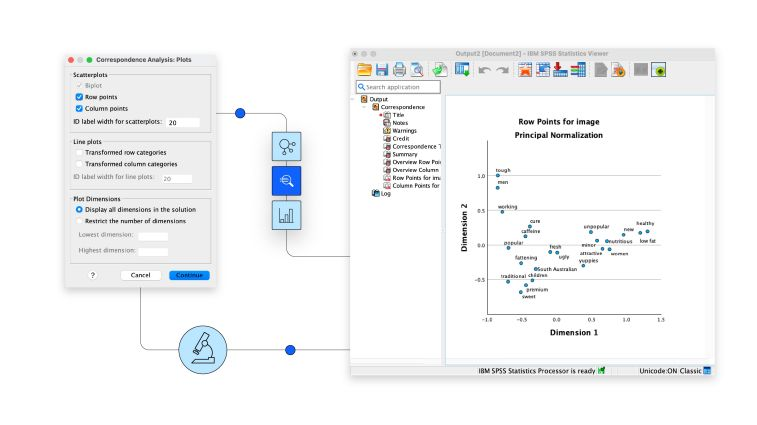Key Takeaways
- Craft Impactful Surveys: Learn the art of crafting surveys that yield valuable insights, from choosing the right question types to maintaining clarity and neutrality.
- Navigate Diverse Channels: Master the diverse channels of survey distribution, including online, phone, and in-person methods, ensuring broad accessibility and user-friendly experiences.
- Transform Insights into Action: Elevate your market research game by not just analyzing data but implementing strategic changes based on survey results, fostering continuous improvement and informed decision-making.
In the ever-evolving landscape of business, where success hinges on informed decision-making and a profound understanding of market dynamics, mastering the art of market research surveying emerges as a crucial skillset.
In this comprehensive guide, we embark on an enlightening journey into the intricacies of market research surveying, unraveling its significance and equipping you with the tools to become a proficient practitioner.

Unveiling the Power of Market Research Surveying
Market research surveying stands as the bedrock of strategic business planning, enabling organizations to unravel consumer preferences, industry trends, and competitive landscapes.
Whether you’re launching a new product, revamping a service, or simply seeking to stay ahead in the market, the insights derived from a well-executed survey can be the compass guiding your business toward success.
As technology continues to redefine consumer behaviors and market dynamics, the ability to conduct effective market research surveys becomes not just advantageous but imperative.
Mastery in this skill empowers businesses to stay agile, adapt to changing landscapes, and, most importantly, connect with their target audience on a profound level.
Navigating Our Essential Guide
This guide isn’t just a primer; it’s a roadmap that unveils the A to Z of market research surveying.
From understanding the fundamentals to crafting effective survey questions, selecting target samples, and interpreting data insights, we leave no stone unturned.
Each section is a treasure trove of knowledge, carefully curated to empower beginners and seasoned professionals alike.
Before diving into the nitty-gritty, we’ll demystify the key concepts and terminologies surrounding market research surveying.
Whether you’re new to the field or looking to refresh your knowledge, this section ensures everyone is on the same page, laying the foundation for an immersive learning experience.
The success of any market research survey lies in meticulous planning. We guide you through the process of setting clear goals, choosing the right methodology, and allocating resources effectively.
This section isn’t just theoretical; it’s a practical guide to turn your survey objectives into actionable plans.
Why Should You Care?
Crafting effective survey questions is an art. We delve into the nuances of open-ended vs. closed-ended questions, the power of Likert scale queries, and the importance of maintaining a neutral tone.
Selecting the right target sample is akin to selecting the right audience for a performance.
We break down the complexities of defining the target population and various sampling techniques, ensuring that your survey reaches the right ears and delivers actionable results.
Embracing the Future
In a world dominated by digital connectivity, understanding the nuances of online surveys, phone surveys, and in-person surveys is paramount.
We explore the pros and cons of each, offering practical insights to help you choose the most effective distribution channels for your specific goals.
Gone are the days of manual data crunching.
We guide you through the process of data cleaning, validation, and analysis, leveraging the power of cutting-edge tools.
Whether you’re a spreadsheet maestro or a data analytics novice, this section caters to all skill levels.
The Journey Continues
As we embark on this exploration of market research surveying, envision yourself not just as a passive reader but an active participant in your professional growth.
Each chapter, each insight, and each practical tip is a stepping stone towards mastering a skill that can redefine your approach to business strategy.
Are you ready to unlock the potential of market research surveying? Let’s dive deep into the intricacies, unravel the mysteries, and emerge not just as informed practitioners but as masters of this indispensable art.
Welcome to the Essential Guide to Mastering Market Research Surveying—a journey that promises to transform the way you perceive and harness the power of data in the business world.
But, before we venture further, we like to share who we are and what we do.
About AppLabx
From developing a solid marketing plan to creating compelling content, optimizing for search engines, leveraging social media, and utilizing paid advertising, AppLabx offers a comprehensive suite of digital marketing services designed to drive growth and profitability for your business.
AppLabx is well known for helping companies and startups use digital marketing to drive web traffic to their websites and web apps.
At AppLabx, we understand that no two businesses are alike. That’s why we take a personalized approach to every project, working closely with our clients to understand their unique needs and goals, and developing customized strategies to help them achieve success.
If you need a digital consultation, then send in an inquiry here.
Market Research Surveying: An Essential Guide To Mastering It
- The Fundamentals of Market Research Surveying
- Crafting Effective Survey Questions
- Selecting a Target Sample
- Conducting the Market Research Survey
- Analyzing and Interpreting Survey Data
- Implementing Changes Based on Survey Results
1. The Fundamentals of Market Research Surveying
In the dynamic realm of business, mastering the fundamentals of market research surveying is akin to laying a sturdy foundation for success.
This section delves into the key concepts, terminologies, and initial planning stages crucial for those seeking to navigate the intricacies of market research surveying.

Key Concepts and Terminology
Understanding Target Audience
Identifying and comprehending your target audience is the cornerstone of effective market research.
Without a clear understanding of who your respondents are, survey results may lack relevance and accuracy.
For example, if you’re launching a new line of tech gadgets, understanding the demographic that predominantly uses such products is essential.
Example: A smartphone manufacturer aiming to launch a new model might target tech-savvy individuals aged 18-35, who are likely to adopt the latest technology trends.

Defining Survey Objectives
Clearly defined objectives set the stage for a successful survey.
Whether you aim to gauge customer satisfaction, measure brand awareness, or understand market trends, the objectives guide the entire survey process.
Example: An e-commerce platform conducting a survey to improve user experience might set objectives such as identifying pain points in the current interface and understanding customer preferences in terms of navigation.

Types of Market Research Surveys
There are various survey types, each serving a specific purpose. Understanding the distinctions is crucial for selecting the most appropriate survey methodology.
Example: A brand launching a new product may opt for an exploratory survey to understand market demand and potential challenges before a full-scale product launch.
Planning Your Market Research Survey
Setting Clear Goals and Objectives
The success of a survey hinges on well-defined goals.
Without a clear purpose, the survey may gather irrelevant data, leading to misguided decisions.
Example: A fast-food chain planning a menu revamp may set goals like understanding customer preferences, identifying popular items, and gauging interest in healthier options.

Choosing the Right Survey Methodology
Selecting the appropriate survey methodology aligns with the objectives.
Whether it’s online surveys, phone interviews, or face-to-face interactions, the choice impacts response rates and data quality.
Example: A political campaign aiming to understand voter sentiments may leverage phone surveys for a personal touch and instant feedback.
Budgeting and Resource Allocation
Even with well-defined goals, a survey requires resources.
Budgeting for survey tools, participant incentives, and analysis resources is essential for a seamless process.
Example: A small business conducting market research may allocate resources for online survey tools, offering discounts to participants, and hiring a data analyst for comprehensive insights.
Understanding and implementing these fundamental concepts and planning steps is the bedrock of successful market research surveying.
As we move forward, we’ll explore the intricacies of crafting effective survey questions, ensuring your survey not only reaches the right audience but also elicits meaningful responses.
2. Crafting Effective Survey Questions
Crafting survey questions is an art that goes beyond simple inquiries; it’s about eliciting insightful and actionable responses.
In this section, we’ll delve into the nuances of formulating questions that not only resonate with your target audience but also yield valuable data for informed decision-making.

Types of Survey Questions
Open-ended vs. Closed-ended
Understanding the distinction between open-ended and closed-ended questions is crucial.
Open-ended questions allow respondents to provide detailed, unrestricted responses, while closed-ended questions offer predefined options for a more structured approach.
Example:
- Open-ended: “Please share your thoughts on our product.”
- Closed-ended: “How satisfied are you with our product?
(Very Satisfied, Satisfied, Neutral, Dissatisfied, Very Dissatisfied)”
Likert Scale Questions
Likert scale questions provide a range of responses, measuring the intensity of agreement or disagreement.
This helps in quantifying opinions and sentiments.
Example: “On a scale of 1 to 5, how likely are you to recommend our services to a friend or colleague?”
Multiple-Choice Questions
Multiple-choice questions offer respondents a set of options to choose from, providing a structured way to collect specific information.
Example: “Which of the following features do you find most valuable in our product?
a) Price b) Performance c) Design d) Customer Support”
Writing Clear and Unbiased Questions
Avoiding Jargon and Complex Language
The clarity of your questions directly impacts the quality of responses.
Avoid industry-specific jargon or complex language that may confuse respondents.
Example: Instead of “How do you perceive our UX/UI design?” consider “What are your thoughts on the look and feel of our website?”
Minimizing Bias in Question Formulation
Bias in questions can skew results.
Ensure questions are neutral and don’t lead respondents towards a particular answer.
Example: Instead of “How satisfied are you with our flawless service?” use “How would you rate your satisfaction with our service?”
Importance of Neutral Tone
Maintaining a neutral tone in questions is paramount.
It fosters an environment where respondents feel comfortable expressing their genuine opinions.
Example: Instead of “Don’t you think our product is superior to competitors?” use “How would you compare our product to competitors?”
Survey Question Effectiveness and Response Rates
Engaging Participants Effectively
Personalization and Relevance
Personalized and relevant questions resonate better with respondents.
Tailor your questions to reflect their experiences and preferences.
Example: “As a frequent shopper, how would you rate the checkout process on our website?”
Clear Instructions and Expectations
Providing clear instructions and setting expectations ensure respondents understand the survey’s purpose, fostering more meaningful responses.
Example: “Please share your thoughts on our recent product launch. Your feedback will help us enhance future releases.”
3. Selecting a Target Sample
Selecting the right target sample is a critical step in ensuring the reliability and representativeness of your market research survey.
In this section, we’ll explore the intricacies of defining the target population, various sampling techniques, and the importance of reaching the right audience for meaningful insights.

Defining the Target Population
Precision in Definition
Defining your target population with precision is the cornerstone of effective sampling.
This involves clearly outlining the characteristics, demographics, and behaviours that align with your survey objectives.
Example: For a survey on electric vehicle adoption, the target population might be defined as urban dwellers aged 25-45 with an annual income above $50,000.

Inclusion and Exclusion Criteria
Establishing inclusion and exclusion criteria further refines your target population, ensuring that your sample is as relevant and representative as possible.
Example: In a survey about smartphone preferences, you might include individuals who own smartphones and exclude those who use only feature phones.
Sampling Techniques
Random Sampling
Random sampling involves selecting participants at random from the larger population, providing each member an equal chance of being included.
This method minimizes bias and enhances the generalizability of results.
Example: In a study on consumer preferences for a new snack, random sampling ensures that every potential consumer has an equal likelihood of being surveyed, offering a comprehensive view.
Stratified Sampling
Stratified sampling divides the population into subgroups or strata based on specific characteristics, and then samples are randomly collected from each stratum.
This method ensures representation from diverse segments.
Example: When studying healthcare preferences, you might stratify the sample by age groups, ensuring insights from both younger and older demographics.

Convenience Sampling
Convenience sampling involves selecting participants based on their accessibility and willingness to participate.
While this method is less rigorous, it can be practical for certain studies.
Example: In a quick feedback survey at a local event, convenience sampling might involve approaching attendees who are readily available to share their opinions.
The Impact of Sampling on Survey Results
Margin of Error and Confidence Level
Understanding the margin of error and confidence level is crucial for interpreting survey results.
A larger sample size generally leads to a smaller margin of error and higher confidence in the findings.
Example: A survey with a 95% confidence level and a 5% margin of error implies that if the survey were conducted 100 times, the results would fall within 5 percentage points of the reported figures in 95 instances.
Representativeness and Generalizability
The representativeness of your sample directly affects the generalizability of your results.
A sample that accurately mirrors the broader population enhances the applicability of your findings.
Example: In political polling, a representative sample that includes a diverse range of demographics ensures the poll’s accuracy in predicting election outcomes.
Ensuring Survey Relevance and Accuracy
Periodic Review of Sampling Criteria
As market dynamics evolve, periodic reviews and adjustments of sampling criteria are essential to ensure that your sample remains reflective of the current population.
Example: A technology company conducting an annual survey on gadget preferences might adjust its sampling criteria to account for emerging trends and changing consumer behaviours.
Utilizing External Data Sources
Leveraging external data sources, such as census data or industry reports, can enhance the accuracy of your sampling strategy by providing additional insights into the demographics and characteristics of your target population.
Example: A healthcare provider conducting a patient satisfaction survey might incorporate demographic data from public health records to ensure a comprehensive understanding of their patient population.

The Impact of Target Sample Quality on Decision-Making
Data-Driven Decision Making
The quality of your target sample directly influences the reliability of the data collected, which, in turn, shapes the effectiveness of data-driven decision-making processes within your organization.
Example: A retail company, basing its inventory decisions on customer preferences gathered through well-constructed surveys, can optimize stock levels and improve overall customer satisfaction.
Mitigating Bias and Error
A carefully selected target sample minimizes biases and errors, enhancing the credibility of your survey results and ensuring that decisions made based on this data are more accurate and actionable.
Example: A political poll using random sampling aims to reduce biases by ensuring that every eligible voter has an equal chance of being surveyed, leading to more accurate predictions.
4. Conducting the Market Research Survey
Conducting a market research survey is a pivotal phase where the carefully laid groundwork comes to fruition.
In this section, we will explore the diverse channels for survey distribution, ensuring accessibility and user-friendliness, and the crucial aspects of managing and monitoring survey responses for actionable insights.

Choosing the Right Survey Distribution Channels
Online Surveys
Online surveys have become a cornerstone of market research due to their accessibility and cost-effectiveness.
Global online survey software market size is expected to reach $6.33 billion by 2028, underscoring the prevalence and importance of this distribution channel.
Example: A tech company seeking feedback on a new app might leverage online surveys distributed via email, social media, or its website to reach a wide audience efficiently.
Phone Surveys
While traditional, phone surveys still hold relevance, especially in industries where a personal touch is valued.
Example: A healthcare provider might use phone surveys to gather patient feedback on their experience with a recent medical visit, ensuring a personalized interaction.
In-person Surveys
In-person surveys offer a face-to-face approach, fostering a deeper connection with respondents. Although resource-intensive, this method can provide rich qualitative data.
Example: A luxury hotel chain might conduct in-person surveys during guest check-out to gather immediate feedback on the overall experience, ensuring a high level of service.

Ensuring Survey Accessibility and User-Friendliness
Mobile Optimization
In an era dominated by smartphones, optimizing surveys for mobile devices is paramount.
In the last quarter of 2023, mobile devices (excluding tablets) generated 58.67 per cent of global website traffic.
Example: A retail brand conducting a customer satisfaction survey ensures that the survey platform is mobile-responsive, accommodating users who prefer accessing surveys on their smartphones.
Clarity in Instructions and Questions
Clarity in survey instructions and questions is vital to prevent participant confusion.
Example: A travel agency crafting a survey on vacation preferences ensures that questions are straightforward and accompanied by clear instructions, enhancing the quality of responses.
Multilingual Surveys
In a globalized market, offering surveys in multiple languages is a best practice for ensuring inclusivity.
Example: An e-commerce platform expanding into international markets ensures that its customer satisfaction survey is available in languages spoken by its diverse customer base.
Managing and Monitoring Survey Responses
Real-time Response Monitoring
Real-time monitoring allows for immediate insights into response patterns, enabling timely adjustments to survey strategies.
Example: A software company launching a new feature conducts real-time response monitoring to identify potential issues and address user concerns promptly.
Data Cleaning and Validation
The integrity of survey data is paramount. Employing data cleaning and validation processes ensures accurate and reliable results.
Example: A financial institution conducting a survey on customer satisfaction employs data cleaning to eliminate duplicate responses and ensure the accuracy of its findings.
Privacy and Data Security
In an age of heightened data concerns, ensuring privacy and data security is non-negotiable. 79% of adults assert they are very or somewhat concerned about how companies are using the data they collect about them.
Example: An online service provider assures participants that their survey responses are anonymized and adheres to stringent data security measures, fostering trust and encouraging candid feedback.
5. Analyzing and Interpreting Survey Data
Analyzing and interpreting survey data is the transformative phase where raw responses metamorphose into actionable insights.
In this section, we will explore the key steps involved in data analysis, the utilization of data analysis tools, and strategies for interpreting survey findings for informed decision-making.

Data Cleaning and Validation
Importance of Data Cleaning
Data cleaning is the initial step in the analysis process, ensuring the removal of errors and inconsistencies.
Bad data causes 88% of American companies to lose 12% of their annual revenue.
Example: A retail company conducting a customer satisfaction survey employs data cleaning to eliminate incomplete responses and inaccurate entries, ensuring the reliability of the collected data.
Validation Procedures
Validation procedures further enhance data integrity by confirming the accuracy and reliability of survey responses.
Example: An educational institution conducting a survey on student satisfaction validates responses by cross-referencing them with student records to ensure the legitimacy of feedback.

Utilizing Data Analysis Tools
Excel for Basic Analysis
Microsoft Excel remains a versatile tool for basic data analysis.
Utilizing features like pivot tables and charts can offer insightful visualizations of survey data.
Example: A small business conducting a product feedback survey employs Excel to analyze responses, creating visual charts to identify trends in customer preferences.

Specialized Tools for Advanced Analysis
Specialized data analysis tools like SPSS, R, or Python can handle more complex analyses.

Example: A technology company conducting a market research survey on user preferences employs Python for advanced sentiment analysis, extracting nuanced insights from textual responses.
Interpreting Findings and Drawing Conclusions
Identifying Key Insights
Identifying key insights involves discerning patterns and trends within the data. Companies that make extensive use of data-driven decision-making are 5% more productive and 6% more profitable than their competitors.
Example: An e-commerce platform analyzes survey data to identify that customers value fast shipping over discounts, leading to a strategic shift in marketing priorities.
Comparative Analysis
Comparative analysis involves comparing survey results across different segments or time periods. This helps in understanding variations and trends.
Example: A food manufacturer compares survey responses on packaging preferences between different age groups, revealing distinct preferences and influencing future product designs.
Implementing Changes Based on Survey Results
Making Informed Business Decisions
The ultimate goal of survey analysis is to guide informed decision-making. Organizations that leverage survey data to inform their decisions are better positioned for success.
Example: A hospitality chain, after analyzing customer feedback, decides to invest in staff training, leading to improved service quality and increased customer satisfaction scores.
Continuous Improvement Strategies
Survey analysis is not a one-time endeavour.
Continuous improvement involves using survey insights iteratively to refine products, services, and customer experiences.
Example: An online retailer, through ongoing survey analysis, identifies evolving customer preferences and adapts its offerings to stay ahead in a competitive market.
6. Implementing Changes Based on Survey Results
Implementing changes based on survey results is the transformative step that propels organizations toward growth and improvement.
In this section, we will explore the best practices for translating survey insights into actionable strategies, making informed business decisions, and fostering a culture of continuous improvement.

Making Informed Business Decisions
Strategic Decision-Making
The primary goal of conducting a market research survey is to inform strategic decision-making.
Example: A software company, after analyzing user feedback through surveys, decides to prioritize the development of features requested by a majority of users, aligning its product roadmap with customer needs.
Prioritizing Key Insights
Not all survey insights are created equal.
Effective decision-making involves prioritizing key insights that align with organizational goals and have the potential for significant impact.
Example: A retail chain, after analyzing survey data, prioritizes enhancing the online shopping experience based on feedback indicating challenges in navigation and checkout processes.
Continuous Improvement Strategies
Iterative Approach to Changes
Implementing changes based on survey results is an iterative process.
It involves continuous refinement and adjustment to align with evolving customer expectations and market dynamics.
Example: An automotive manufacturer, receiving feedback on vehicle safety concerns through surveys, implements iterative design improvements in subsequent models to address customer concerns.
Agile Implementation
Agile methodologies are increasingly applied to implement changes swiftly and adapt to feedback.
Example: An e-commerce platform, responding to customer preferences identified in surveys, employs agile development practices to quickly implement changes and stay ahead of market trends.
Tracking and Measuring Impact
Key Performance Indicators (KPIs)
Establishing KPIs helps measure the impact of implemented changes.
Example: A hospitality chain, after enhancing its loyalty program based on customer feedback, tracks KPIs such as customer retention rates and repeat bookings to measure program effectiveness.
Customer Satisfaction Metrics
Customer satisfaction metrics, such as Net Promoter Score (NPS), provide tangible insights into the impact of changes on customer sentiment.
Example: An airline, implementing changes in in-flight services based on passenger feedback, might see an increase in its NPS as passengers express higher satisfaction with the overall travel experience.

Cultivating a Culture of Continuous Improvement
Employee Engagement
Incorporating employee feedback into the improvement process fosters a culture of continuous improvement.
Example: A manufacturing company, seeking employee input through internal surveys, implements changes to workflow based on suggestions, leading to increased efficiency and job satisfaction.
Customer Feedback Loops
Establishing customer feedback loops ensures ongoing communication with the target audience.
53% of customers expect companies to respond to negative feedback within one week.
Example: A technology company, utilizing continuous customer feedback loops, iteratively updates its software features to address user concerns, ensuring a user-centric product.
Conclusion
Laying the Foundation: Fundamentals and Planning
In mastering market research surveying, a solid foundation is paramount. Understanding key concepts and terminology, coupled with meticulous planning, sets the stage for a successful survey.
From defining the target audience to allocating resources effectively, the fundamentals provide the groundwork for precision and relevance.
Crafting Effective Survey Questions: The Art of Eliciting Insights
The artistry of market research surveying shines through in the crafting of effective survey questions. Whether employing open-ended, closed-ended, or Likert scale questions, the goal is to elicit valuable responses.
Selecting a Target Sample: Precision in Population Representation
Selecting the right target sample is a science that involves defining the target population with precision and employing suitable sampling techniques.
Whether through random, stratified, or convenience sampling, the aim is to ensure representation and relevance in survey responses.
Conducting the Market Research Survey: Navigating Diverse Channels
Navigating the diverse channels of survey distribution is a critical aspect of market research surveying. Online, phone, and in-person surveys each play a role, catering to diverse survey needs.
Ensuring accessibility and user-friendliness, exemplified by mobile optimization and clear instructions, enhances the survey experience.
Analyzing and Interpreting Survey Data: Transforming Insights into Action
The transformation of raw responses into actionable insights occurs in the analysis phase. Data cleaning and validation are the initial steps, ensuring the reliability of survey data.
Utilizing tools like Excel for basic analysis or specialized tools for advanced insights, the process involves identifying key insights and drawing conclusions for informed decision-making.
Implementing Changes Based on Survey Results: From Insight to Impact
Implementing changes based on survey results is the transformative phase where organizations move from insight to impact. Making informed business decisions involves strategic decision-making and prioritizing key insights.
Continuous improvement strategies, an iterative approach, and agile implementation ensure that organizations remain dynamic and responsive to evolving needs.
Mastering the Journey Ahead
As we conclude this essential guide to market research surveying, envision yourself not just as an informed practitioner but as a transformative force within your organization.
The insights derived from surveys are not merely data points; they are the compass guiding you towards innovation, growth, and sustained success.
Embrace the art of market research surveying, refine your skills, and let the insights you glean propel your organization towards not just mastering the present but also anticipating and shaping the future. Happy surveying.
If you are looking for a top-class digital marketer, then book a free consultation slot here.
If you find this article useful, why not share it with your friends and business partners, and also leave a nice comment below?
We, at the AppLabx Research Team, strive to bring the latest and most meaningful data, guides, and statistics to your doorstep.
To get access to top-quality guides, click over to the AppLabx Blog.
People also ask
What is a market research survey?
A market research survey is a systematic method of collecting, analyzing, and interpreting data from a target audience to gain insights into their preferences, behaviours, and opinions. Employed by businesses, it informs strategic decisions, product development, and overall market understanding.
How to write a market research report PDF?
To write a market research report PDF, outline the purpose, methodology, and findings. Include an executive summary, introduction, research objectives, data analysis, and conclusion. Incorporate visuals for clarity. Ensure a concise, structured, and actionable document for effective communication.
What is basic market research?
The basic principles of market research involve defining objectives, identifying the target audience, choosing appropriate methodologies, collecting and analyzing data, and interpreting findings. It’s a systematic process to gain insights into consumer behaviour, preferences, and market trends.

































